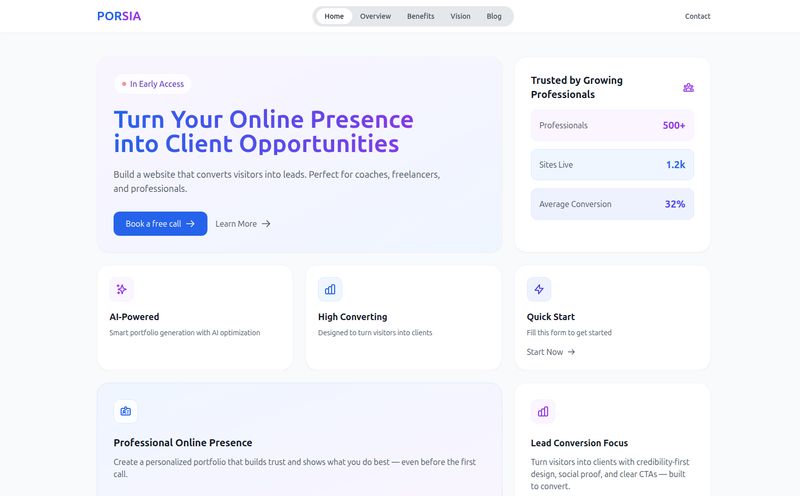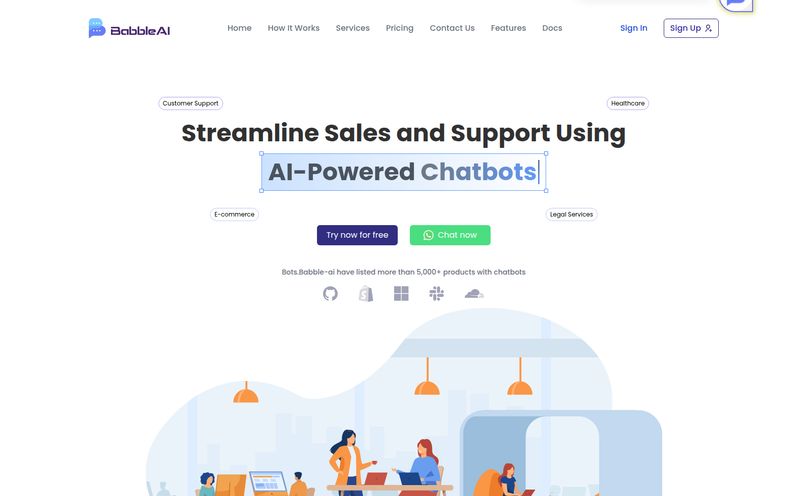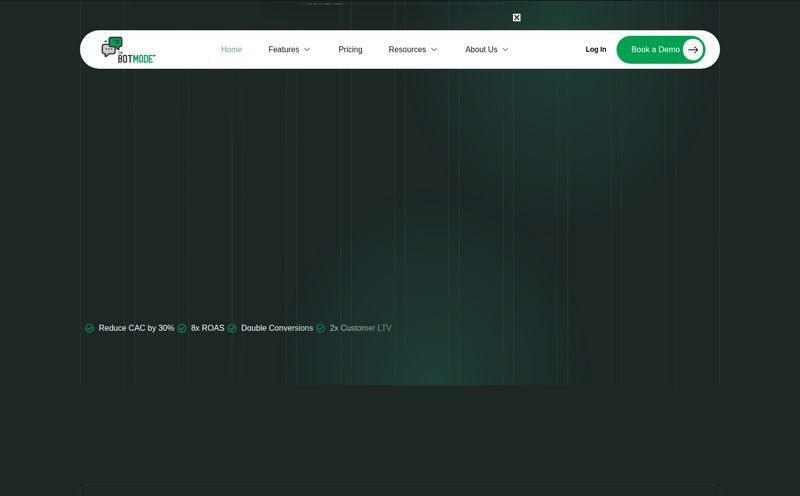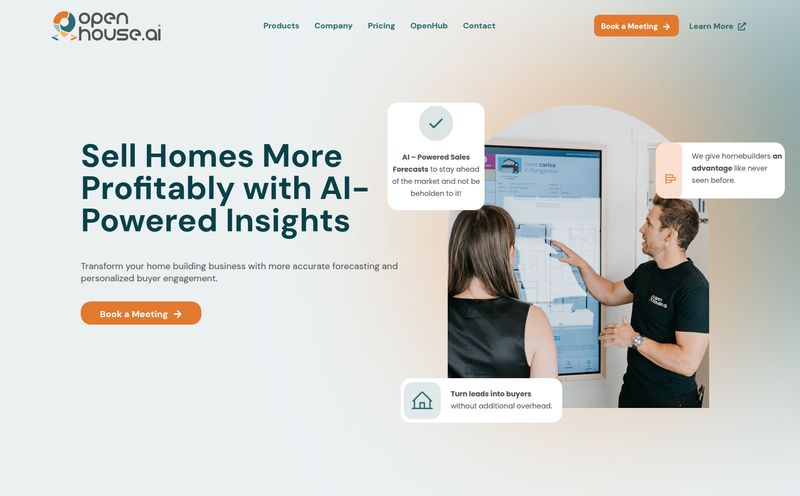For years, I've been neck-deep in the world of SEO, traffic, and the eternal quest for conversions. We build beautiful websites, craft what we think is killer content, and drive traffic like our careers depend on it (because they do). But then what? The traffic hits the site, and we cross our fingers, hoping someone fills out that dusty old 'Contact Us' form. It's a bit like throwing a massive party and then hiding in the kitchen, just hoping people have a good time on their own.
The traditional answer has always been the SDR team—the Sales Development Reps. The front-line soldiers tasked with sifting through the digital noise, pouncing on anyone who shows a flicker of interest, and trying to figure out if they're a genuine prospect or just a student doing research for a term paper. It's a tough, expensive, and often soul-crushing gig. I've seen the burnout firsthand.
So when I stumbled upon a tool called Conversational Demos, my professional curiosity went into overdrive. The premise is bold, almost audacious: convert visitors into sales-qualified leads using interactive demos, without SDRs. My first thought? Yeah, right. My second thought? Okay, tell me more.
So, What Exactly is This Thing?
Let's cut through the marketing fluff. At its core, Conversational Demos is a platform that takes your existing video assets—think product tours, recorded webinars, feature explanations—and turns them into interactive experiences. It’s like giving your prerecorded videos a brain and a voice.
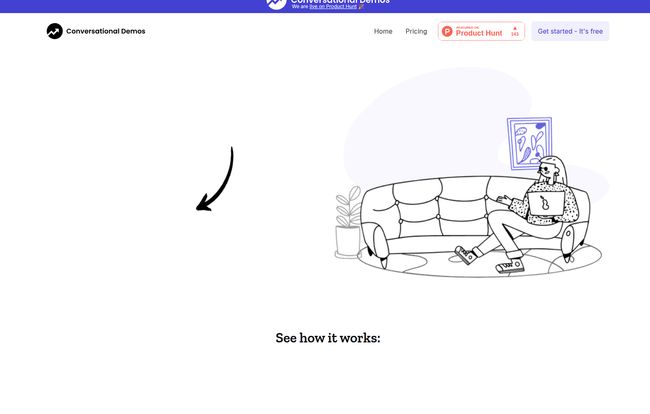
Visit Conversational Demos
Imagine a visitor lands on your pricing page. Instead of just watching a passive video, they can now talk to it. They can ask questions in a chat interface right alongside the video, and an AI will provide instant answers based on the content. The tool can then ask qualifying questions back, like "What's your company size?" or "What's your biggest challenge with X?"
It’s not just a chatbot slapped onto a video player. It's a system designed to guide a prospect through a discovery process, gather crucial data, and decide if they're a hot lead worth a sales exec's time. It's basically an automated qualification engine powered by the content you've already created. Pretty neat, huh?
Putting Your Dormant Videos on the Payroll
I have a folder on a cloud drive that I bet looks a lot like yours. It’s a graveyard of perfectly good video content. Webinars from last quarter, a slick product demo we paid a fortune for, tutorials we made for a feature that's since been updated. They had their moment in the sun and now... they just sit there, depreciating like a new car.
Conversational Demos promises to resurrect this content. That webinar you ran six months ago? It can become an evergreen lead magnet that qualifies prospects 24/7. That product tour? It's no longer a one-way presentation; it's a two-way discovery call that happens on the visitor's terms, at their own pace. This, for me, is the real game-changer. It's not about creating more content, it’s about making the content you already have work a hell of a lot harder.
The Key Features That Caught My Eye
I'm a features guy. I like to pop the hood and see what makes the engine run. While the platform is straightforward, a few things really stand out from an SEO and marketing ops perspective.
Auto-Qualified Leads are the Holy Grail
Let’s be honest, not all leads are created equal. The biggest time-suck for any sales team is chasing down MQLs (Marketing Qualified Leads) that are, to put it politely, lukewarm. Conversational Demos automates this sorting process. You set the criteria for what makes a lead 'sales-qualified' (SQL). Is it a certain company size? A specific pain point? A budget question? The interactive demo gathers this info and flags the lead as an SQL in real-time. This means your sales team only talks to people who are genuinely ready to talk. The efficiency gain here is... massive.
Lead Insights That Don't Suck
You get more than just a name and an email. You get a transcript of their entire interaction. You know exactly what questions they asked, what features they were interested in, and what their objections were before you even hop on a call. It's like having a cheat sheet for every sales conversation. This data is gold not just for sales, but for marketing too. Are tons of people asking about a feature you barely mention? Maybe it's time to update your homepage copy.
Seamless CRM Integrations
A new tool is useless if it doesn't play nice with your existing stack. I was relieved to see they offer CRM integrations. Automatically pushing a hot, qualified lead with all its associated data directly into your HubSpot or Salesforce instance without manual data entry is just... chef's kiss. It closes the loop between marketing effort and sales action.
An Honest Look at the Pros and Cons
No tool is perfect, and I'm not here to sell you snake oil. As much as I'm intrigued by Conversational Demos, it's important to look at it with a critical eye.
On the plus side, the automation of lead qualification is a huge win. Reducing reliance on a large SDR team could save a company a small fortune, especially in today's tight hiring market. The potential for enhanced lead engagement is real; people are more likely to stay on your page if they're actively interacting with content. The insights are genuinely valuable, and the ability to use existing videos is a low-friction way to get started.
However, let's pump the brakes a little. The effectiveness of this whole system hinges entirely on the quality of your video content and how well the AI is trained on it. If your demo is confusing or your webinar is boring, no amount of AI can save it. Also, while AI is impressive, it can't replicate the nuance and empathy of a skilled human SDR. There will always be complex, out-of-the-box questions that an AI will struggle with. And a small but real point—the need for cookie consent pop-ups and data tracking can sometimes add a layer of friction to the user experience, though that's a battle we're all fighting these days.
"My two cents? Don't think of it as a 1-for-1 replacement for your entire sales development team. Think of it as your first responder. It handles the initial contact, filters out the noise, and tees up the prime opportunities for your human experts to close."
The All-Important Question: What's the Price Tag?
Okay, this is the part where I expected to see a complicated, multi-tiered pricing structure that would require a spreadsheet to decipher. I clicked on their pricing page, ready for the usual SaaS sticker shock, and I had to read it twice to make sure I wasn't hallucinating.
| Plan | Cost |
|---|---|
| Free | $0. All features are currently completely free! |
You read that right. As of this writing, Conversational Demos is completely free. All features. This is... wild. My assumption is that they're in a growth phase, trying to capture market share, and will likely introduce paid tiers later. But for now? This removes literally every barrier to entry. There is no reason not to try it.
Final Thoughts: Is It Worth Your Time?
I've seen a lot of tools come and go. Most are just slight variations on an old theme. Conversational Demos feels different. It’s tackling a real, expensive problem that almost every B2B company faces. The idea of making our content work for us—truly work for us—is incredibly appealing.
Is it going to put every SDR out of a job tomorrow? No. But could it transform the role of an SDR from a cold-calling-grind into a more strategic, high-level position focused only on the hottest leads? Absolutely. Could it allow a smaller, leaner startup to punch way above its weight in sales qualification? You bet.
Given that it's currently free, my recommendation is a no-brainer. If you have video content and a desire to improve your lead quality and conversion rates, you should sign up. Yesterday. Play with it, test it, see what it can do. You have literally nothing to lose and a whole lot of qualified leads to gain.
Frequently Asked Questions
- 1. Does Conversational Demos replace the need for a human sales team?
- Not entirely. It’s designed to replace the top-of-funnel qualification work often done by SDRs. It handles the initial screening, so your human sales executives can focus their time on closing pre-qualified, high-intent leads.
- 2. What kind of videos work best with this platform?
- Product demos, recorded webinars, feature overview videos, and even in-depth tutorials work great. The key is that the video should contain the information a potential customer would need to make a decision, as the AI uses this content to answer questions.
- 3. How hard is it to set up?
- The setup seems pretty straightforward. You upload your video, the platform's AI 'watches' and learns from it, and then you can embed the interactive player on your website. You'll also want to configure your lead qualification rules and connect it to your CRM.
- 4. Is it really free? What's the catch?
- As of now, yes, their website states that all features are completely free. It's common for new platforms to offer free access initially to build a user base. It's possible they will introduce paid plans in the future, but early adopters often get a great deal.
- 5. Can I customize the questions it asks to qualify leads?
- Yes. You have control over the qualification criteria. You can define what makes a lead an SQL for your specific business, whether it’s based on company size, industry, specific needs, or budget-related questions.
Reference and Sources
- Conversational Demos Official Website
- Conversational Demos Pricing Page
- Conversational Demos on Product Hunt
